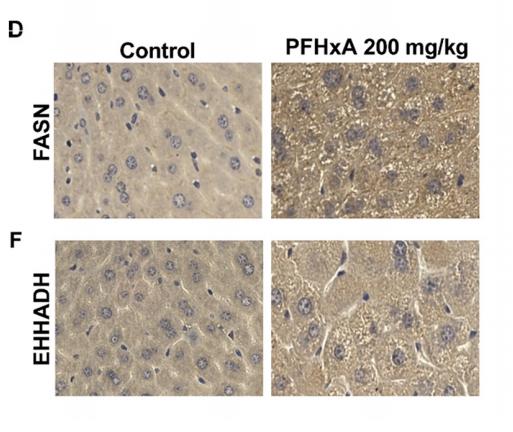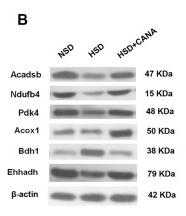EHHADH Antibody - #DF4280
| Product: | EHHADH Antibody |
| Catalog: | DF4280 |
| Description: | Rabbit polyclonal antibody to EHHADH |
| Application: | WB IHC IF/ICC |
| Cited expt.: | WB, IHC |
| Reactivity: | Human, Mouse, Rat |
| Prediction: | Horse, Sheep, Dog, Xenopus |
| Mol.Wt.: | 80 KD; 79kD(Calculated). |
| Uniprot: | Q08426 |
| RRID: | AB_2836631 |
Related Downloads
Protocols
Product Info
*The optimal dilutions should be determined by the end user. For optimal experimental results, antibody reuse is not recommended.
*Tips:
WB: For western blot detection of denatured protein samples. IHC: For immunohistochemical detection of paraffin sections (IHC-p) or frozen sections (IHC-f) of tissue samples. IF/ICC: For immunofluorescence detection of cell samples. ELISA(peptide): For ELISA detection of antigenic peptide.
Cite Format: Affinity Biosciences Cat# DF4280, RRID:AB_2836631.
Fold/Unfold
3 hydroxyacyl CoA dehydrogenase; 3,2 trans enoyl CoA isomerase; 3-hydroxyacyl-CoA dehydrogenase; ECHD; ECHP_HUMAN; EHHADH; Enoyl Coenzyme A, hydratase/3 hydroxyacyl Coenzyme A dehydrogenase; L 3 hydroxyacyl CoA dehydrogenase; L bifunctional protein, peroxisomal; L PBE; LBFP; LBP; MGC120586; MS730; PBE; PBFE; Peroxisomal bifunctional enzyme; Peroxisomal enoyl CoA hydratase;
Immunogens
A synthesized peptide derived from human EHHADH, corresponding to a region within the internal amino acids.
Liver and kidney. Strongly expressed in the terminal segments of the proximal tubule. Lower amounts seen in the brain.
- Q08426 ECHP_HUMAN:
- Protein BLAST With
- NCBI/
- ExPASy/
- Uniprot
MAEYTRLHNALALIRLRNPPVNAISTTLLRDIKEGLQKAVIDHTIKAIVICGAEGKFSAGADIRGFSAPRTFGLTLGHVVDEIQRNEKPVVAAIQGMAFGGGLELALGCHYRIAHAEAQVGLPEVTLGLLPGARGTQLLPRLTGVPAALDLITSGRRILADEALKLGILDKVVNSDPVEEAIRFAQRVSDQPLESRRLCNKPIQSLPNMDSIFSEALLKMRRQHPGCLAQEACVRAVQAAVQYPYEVGIKKEEELFLYLLQSGQARALQYAFFAERKANKWSTPSGASWKTASARPVSSVGVVGLGTMGRGIVISFARARIPVIAVDSDKNQLATANKMITSVLEKEASKMQQSGHPWSGPKPRLTSSVKELGGVDLVIEAVFEEMSLKKQVFAELSAVCKPEAFLCTNTSALDVDEIASSTDRPHLVIGTHFFSPAHVMKLLEVIPSQYSSPTTIATVMNLSKKIKKIGVVVGNCFGFVGNRMLNPYYNQAYFLLEEGSKPEEVDQVLEEFGFKMGPFRVSDLAGLDVGWKSRKGQGLTGPTLLPGTPARKRGNRRYCPIPDVLCELGRFGQKTGKGWYQYDKPLGRIHKPDPWLSKFLSRYRKTHHIEPRTISQDEILERCLYSLINEAFRILGEGIAASPEHIDVVYLHGYGWPRHKGGPMFYASTVGLPTVLEKLQKYYRQNPDIPQLEPSDYLKKLASQGNPPLKEWQSLAGSPSSKL
Predictions
Score>80(red) has high confidence and is suggested to be used for WB detection. *The prediction model is mainly based on the alignment of immunogen sequences, the results are for reference only, not as the basis of quality assurance.
High(score>80) Medium(80>score>50) Low(score<50) No confidence
Research Backgrounds
Acetylated, leading to enhanced enzyme activity. Acetylation is enhanced by up to 80% after treatment either with trichostin A (TSA) or with nicotinamide (NAM) with highest increase on Lys-346. Acetylation and enzyme activity increased by about 1.5% on addition of fatty acids.
Peroxisome.
Liver and kidney. Strongly expressed in the terminal segments of the proximal tubule. Lower amounts seen in the brain.
In the N-terminal section; belongs to the enoyl-CoA hydratase/isomerase family.
In the C-terminal section; belongs to the 3-hydroxyacyl-CoA dehydrogenase family.
Research Fields
· Cellular Processes > Transport and catabolism > Peroxisome. (View pathway)
· Metabolism > Lipid metabolism > Fatty acid degradation.
· Metabolism > Amino acid metabolism > Valine, leucine and isoleucine degradation.
· Metabolism > Amino acid metabolism > Lysine degradation.
· Metabolism > Amino acid metabolism > Tryptophan metabolism.
· Metabolism > Metabolism of other amino acids > beta-Alanine metabolism.
· Metabolism > Carbohydrate metabolism > Propanoate metabolism.
· Metabolism > Carbohydrate metabolism > Butanoate metabolism.
· Metabolism > Global and overview maps > Metabolic pathways.
· Metabolism > Global and overview maps > Carbon metabolism.
· Metabolism > Global and overview maps > Fatty acid metabolism.
· Organismal Systems > Endocrine system > PPAR signaling pathway.
References
Application: IHC Species: Mice Sample: liver tissue
Application: WB Species: Rat Sample:
Restrictive clause
Affinity Biosciences tests all products strictly. Citations are provided as a resource for additional applications that have not been validated by Affinity Biosciences. Please choose the appropriate format for each application and consult Materials and Methods sections for additional details about the use of any product in these publications.
For Research Use Only.
Not for use in diagnostic or therapeutic procedures. Not for resale. Not for distribution without written consent. Affinity Biosciences will not be held responsible for patent infringement or other violations that may occur with the use of our products. Affinity Biosciences, Affinity Biosciences Logo and all other trademarks are the property of Affinity Biosciences LTD.



